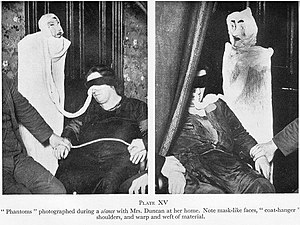
Back إكتوبلازم Arabic ইক্টোপ্লাজম (ভৌতিক) Bengali/Bangla Ectoplasma (paranormal) Catalan Ektoplasma (parapsykologi) Danish Ektoplasma (Parapsychologie) German Ectoplasma (parapsicología) Spanish اکتوپلاسم (فراطبیعی) Persian Ektoplasma (parapsykologia) Finnish Ectoplasme (parapsychologie) French Ektoplazma Croatian

| Part of a series on the |
| Paranormal |
|---|
In spiritualism, ectoplasm, also known as simply ecto, is a substance or spiritual energy "exteriorized" by physical mediums. It was coined in 1894 by psychical researcher Charles Richet.[1] Although the term is widespread in popular culture,[2] there is no scientific evidence that ectoplasm exists[3][4][5][6] and many purported examples were exposed as hoaxes fashioned from cheesecloth, gauze or other natural substances.[7][8]
The term comes from the Ancient Greek words ἐκτός ektos, "outside" and πλάσμα plasma, "anything formed".
- ^ Blom, Jan Dirk. (2010). A Dictionary of Hallucinations. Springer. p. 168. ISBN 978-1-4419-1222-0
- ^ Badley, Linda (1995). Film, Horror, and the Body Fantastic. Westport, Connecticut: Greenwood Publishing Group. pp. 45–. ISBN 978-0-313-27523-4.
- ^ Pulliam, June; Fonseca, Anthony (26 September 2016). Ghosts in Popular Culture and Legend. Santa Barbara, California: ABC-CLIO. pp. 89–. ISBN 978-1-4408-3491-2.
- ^ Cite error: The named reference
Keenewas invoked but never defined (see the help page). - ^ "Ectoplasm" Archived 2011-01-11 at the Wayback Machine. Glossary of Key Words Frequently Used in Parapsychology, Parapsychological Association (2006-01-24).
- ^ Hines, Terence (2003). Pseudoscience and the Paranormal. Amherst, New York: Prometheus Books. pp. 44–. ISBN 978-1-61592-085-3.
- ^ Stein, Gordon (1993). Encyclopedia of Hoaxes. Farmington Hills, Michigan: Gale Group. p. 205. ISBN 0-8103-8414-0.
One strange phenomena of spiritualism, once popular, was the production of ectoplasm. This was a white substance that appeared to ooze from various openings of the medium's body. It was usually made of gauze, chiffon, or cheesecloth, often soaked or treated with various substances.
- ^ Frazier, Kendrick (2009). Science Under Siege: Defending Science, Exposing Pseudoscience. Amherst, New York: Prometheus Books. pp. 330–. ISBN 978-1-61592-594-0.